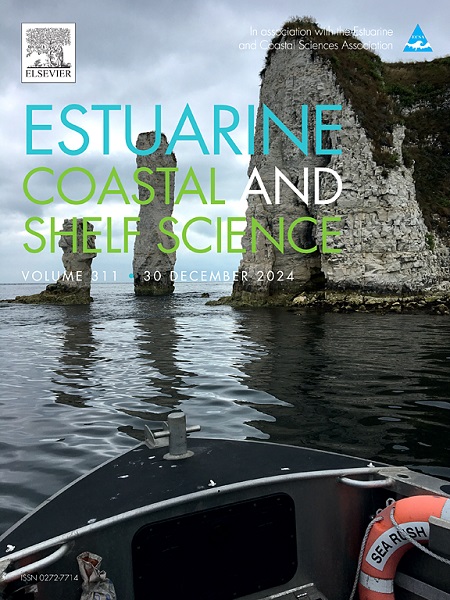波河三角洲泻湖(北亚得里亚海)底栖生物原核多样性是由河流淡水输入形成的
IF 2.6
3区 地球科学
Q1 MARINE & FRESHWATER BIOLOGY
引用次数: 0
摘要
亚得里亚海拥有几个高产的泻湖,这些泻湖是许多水生生物的重要栖息地,也是与邻近沿海海的关键连接点。研究了意大利北部亚得里亚海波河三角洲7个主要泻湖底栖生物的原核多样性和群落组成。我们的目的是探讨每个泻湖是否拥有不同的微生物组合,以及河流输入和人为污染物如何影响群落结构。我们的研究结果揭示了泻湖中底栖原核生物群落的多样性和组成存在显著差异,并且单个泻湖内部也存在显著差异。在河流投入较高的站点,淡水类群对整体群落的重要性较高。在多个地点发现粪便和污水相关细菌,突出了人为污染物的发生。然而,它们的丰度与淡水类群的丰度并不相关,这表明它们不仅受河水的影响。多元统计分析表明,沉积物粒度、营养物、Al、Fe含量和无机污染物(as、Hg、Ni、Pb、Zn)浓度等因素对泻湖原核生物群落的组装机制有显著影响。我们的研究结果表明,河流淡水输入和人类活动共同塑造了这些泻湖的微生物组成,这与它们与亚得里亚海的密切联系是一致的。此外,它们可能促进潜在致病菌向邻近沿海水域传播,可能影响水质和娱乐活动。本文章由计算机程序翻译,如有差异,请以英文原文为准。

Benthic prokaryotic diversity in Po River delta lagoons (North Adriatic Sea) is shaped by riverine freshwater inputs
The Adriatic Sea hosts several highly productive lagoons that serve as critical habitats for many aquatic organisms, but also as key connectivity sites with the adjacent coastal sea. This study investigates the benthic prokaryotic diversity and community composition in the seven main lagoons of the Po River delta (Northern Adriatic Sea, Italy). We aimed to explore whether each lagoon hosts different microbial assemblages and how riverine inputs and anthropogenic pollutants affect community structure Our findings revealed significant differences in the diversity and composition of benthic prokaryotic communities across the lagoons, as well as a substantial variability within individual lagoons. The significance of freshwater taxa to the overall communities was higher in stations where higher river inputs were expected. Feces- and sewage-associated bacteria were found at multiple locations, highlighting the occurrence of anthropogenic contaminants. However, their abundance, did not correlate with the abundance of freshwater taxa, suggesting that they are not only influenced by riverine waters. Multivariate statistical analysis indicated that various factors, such as sediment grain size, nutrient, Al, Fe contents and concentration of inorganic pollutants (As, Hg, Ni, Pb, Zn) significantly contribute to the assembly mechanisms of prokaryotic communities in these lagoons. Our results imply that riverine freshwater inputs and human activities jointly shape the microbial composition of these lagoons, which is consistent with their close connection to the Adriatic Sea. Furthermore, they may facilitate the spread of potentially pathogenic bacteria to the adjacent coastal waters, potentially impacting water quality and recreational activities.
求助全文
通过发布文献求助,成功后即可免费获取论文全文。
去求助
来源期刊
CiteScore
5.60
自引率
7.10%
发文量
374
审稿时长
9 months
期刊介绍:
Estuarine, Coastal and Shelf Science is an international multidisciplinary journal devoted to the analysis of saline water phenomena ranging from the outer edge of the continental shelf to the upper limits of the tidal zone. The journal provides a unique forum, unifying the multidisciplinary approaches to the study of the oceanography of estuaries, coastal zones, and continental shelf seas. It features original research papers, review papers and short communications treating such disciplines as zoology, botany, geology, sedimentology, physical oceanography.

 求助内容:
求助内容: 应助结果提醒方式:
应助结果提醒方式:


